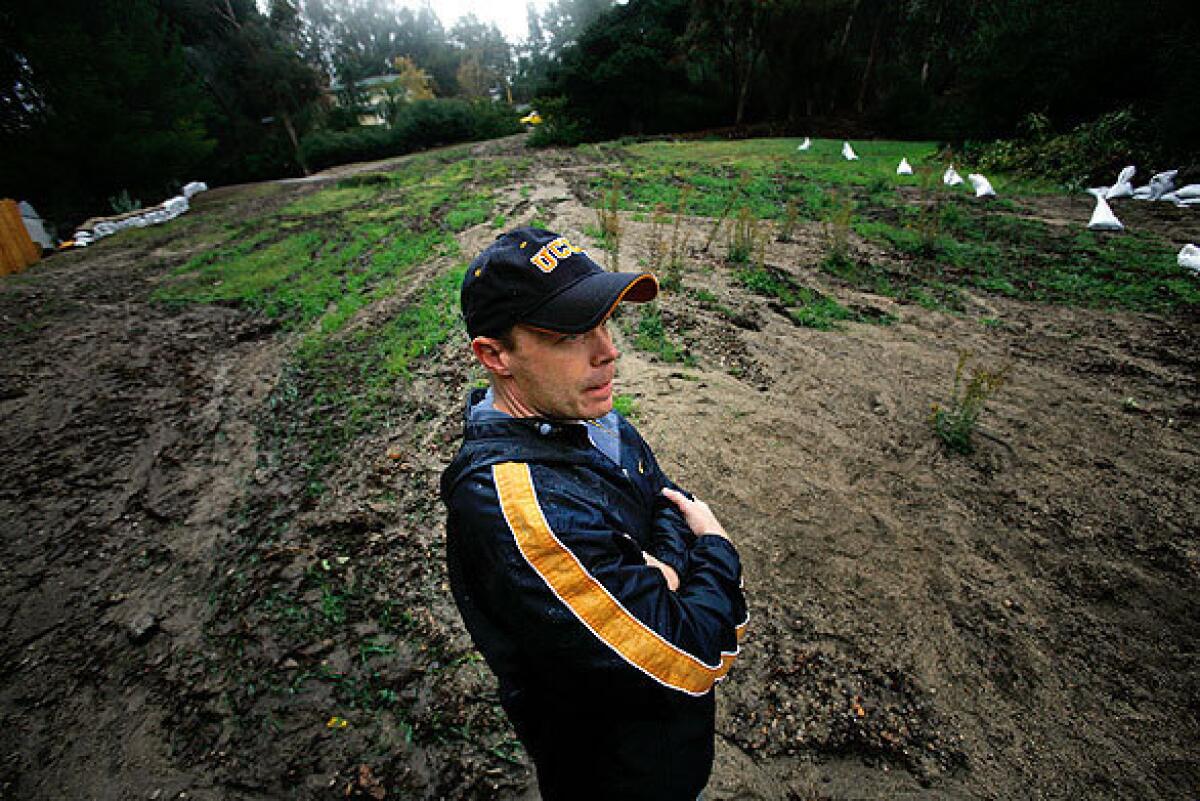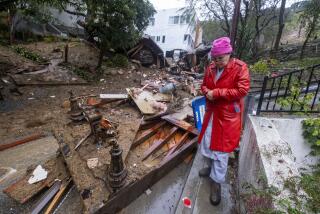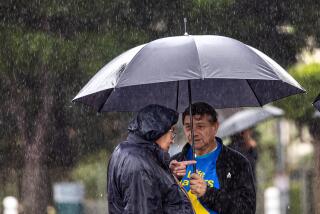For residents of the Station fire burn area, mud flows bring creeping fear

When the rain started to fall, Janet Blake started to worry. From the picture window of her home, she could see the stream that was once her street become a torrent of stones, branches and mud.
The fire was easier, she thought; that was only six days of worry. The possibility of the mountain sliding down upon her is indefinite.
Her husband, Brian Hodge, worked in the other room, and Cooper, their yellow lab, stood beside her, his tail merrily striking the ornaments on the Christmas tree.
Janet and Brian live in the foothills of La Crescenta, a community that’s filled with worry nowadays. The Station fire was only the beginning. Just as the smoke started to clear, the warnings began of debris flows barreling down the burned hillsides, and every drop of rain from last weekend’s storm brought new cause for concern.
The rain beat loudly on the roof. Janet was not surprised. Saturday morning, like every morning since late September, she checked the National Weather Service website. She also read the mud4cast, an e-mail blast from the county, but she knows predictions are never entirely accurate.
The brunt of the storm would arrive later that evening and with it, up to 2 1/2 inches of rain. Runoff fanned across the street, roostertailing over rocks and branches, broadsiding the concrete barriers put up by the county.
Janet and Brian live on Canyonside Road, a charming cul-de-sac when the sun is shining but under threatening skies a chute for the debris that the mountains slough off. Last month, she and Brian returned from a concert downtown. As they got closer to home, the light drizzle turned to a downpour, and they narrowly made it into their driveway amid a deluge of muddy water, rock and boulders.
Weeks before, the county strategically placed a dozen or so K-rails, the waist-high concrete traffic barriers, to manage runoff. They jutted diagonally into the street here and there -- neighbor Lisa Dupuy said they made Canyonside Road look like a pinball machine -- but the precautions seemed to work. During the November storm, no property was damaged.
A sudden shift in the jet stream, though, and a different story could unfold.
The storm began to lighten; pelting turned to mist. There was a knock on the front door. Olin Younger wanted to see how Janet and Brian were faring. She would have invited him in, but a sheet of plywood, 4 feet tall, had been nailed across the bottom half of the entrance to keep the mud out. Cooper jumped up and rested his paws on the top of the barricade.
“Are you staying, Olin?” Janet asked.
“Oh yeah,” Younger replied, even though his home was just below hers and in an exposed crook in the road.
“Well, we have a second bedroom if you need a place to stay,” she said.
A few hours earlier Janet had been told by a fire official that if too much mud and debris covered the street, the county might not be able to clear it. Janet and Brian might not be able to drive out, he said. All afternoon, a skip loader had been working in the rain, scraping Canyonside Road of any accumulation.
Like her neighbors, Janet had long ago weighed the pluses and minuses of living in the foothills, and up until this year, the risks had made sense.
She and Brian moved here in 1983. They had just gotten married. She was from Queens, newly arrived in Los Angeles, and he was an attorney from Pasadena. He found the place, and she, a city girl whose taste ran more to theater than trees, had to adjust. Her ears popped three times when they drove up the mountain.
During the ’84 Olympics, they watched fireworks over the Coliseum from their backyard. On especially clear days, they can see Catalina Island floating on the horizon. At night they watch for comets in the starry skies and during the winter delight when snow falls and stays.
Outside, the gray afternoon light grew dim. Wraiths of fog and low clouds settled upon the street, blurring distinctions. Gauzy figures with umbrellas passed. Lights from neighbors’ homes reflected in the sheen of water, purling by. The road crew was still at work, now filling a dump truck.
The Station fire in August and September had been a test, but little did Janet suspect that it would set the stage for other questions. How do you stop a debris flow? Is it possible? Until plants returned to the slopes and set down roots, the mountain could fall upon them at any moment.
Brian wandered into the living room.
“I think we’ll be OK,” he said looking out the window.
During the fire, he had been reluctant to leave. Eventually they did, but she understood his hesitancy. Their home meant too much to him. What once had been a cabin of sorts -- built in the early ‘50s when La Crescenta was a faraway corner of L.A. County -- had become their sanctuary.
They remodeled, made it their own: A split-level painted peach to reflect their love of the Southwest, it sat beneath a canopy of Canary pines, cedars, redwoods and firs and overlooked Pickens Canyon. They planted roses, camellias and fruit trees. He put up a greenhouse for seedlings, once growing up to 20 varieties of tomatoes.
When they returned six days after the fire, she felt jubilant, blessed. They set about cleaning up, mopping everything with chemical sponges, running special air conditioners. Life was suddenly different: displaced wildlife, rumors of more mountain lions and wind that carried with it a fine, powdery silt that crept under windowsills.
Then one day Janet noticed six strangers measuring her driveway. When she asked what they were doing, a young woman from the county told her about the mudflows.
“You have to get ready,” she said.
Mt. Lukens rises above Canyonside Road. The tallest peak in the area at about 5,000 feet, Lukens shares the fate of all the mountains in L.A.’s transverse range. Cut through by faults, fractured and riven, its rocks -- a combination of decomposed granite and a brittle surface stone called regolith -- are quick to crumble and tumble down, a fact that helps account for the catastrophic debris flows in its past: the Pinecrest flood of 1978, the Montrose flood of 1934, both occurring after devastating fires.
“Ready,” as the county advised Janet, meant a 4-foot plywood wall between the house and the street and more than $100 worth of sandbags to supplement the wall and K-rails. It was the control of nature, writ small, a peashooter against an elephant; and when Janet asked for a K-rail to be placed in front of her house, the chief engineer and road supervisor agreed. When it arrived, she felt as if Allied troops had come to rescue her.
In years past, Brian would set out an elaborate Christmas display. This year the display is a Christmas tree stuck at the base of the K-rail in front of the house. Its red and green lights glowed through the sheets of rain.
Janet knows that the imagination inspires fear, but she has tangible touchstones for her worry: if not the Station fire, then certainly the times she was diagnosed with breast cancer, first in 1987 and then in 2005. Perhaps more than most of her neighbors, she knows something about the randomness of survival.
She and her neighbors have factored their margins of safety. Everywhere you live there are risks, they will say, so you live with varying degrees of denial. Control, after all, is an illusion, and their illusion at the moment is more precarious than most.
The phone rang. It was Janet’s brother in Valley Village. He wanted to make sure that she and Brian were safe. Outside, the timbre of the water in the street grew deeper, more gravelly. Janet recognized the change: a new wave of mud and rocks driven perhaps by stronger showers farther up the mountain. The wet air carried the pungent smell of charred wood and ash.
At the top of the stairs, out of reach of any ground-floor flooding, she keeps three bags packed with a change of clothes, insurance papers, contact numbers, her personal writing and power cords for her iPod and computer. There is nothing sentimental here, nothing to mark her 61 years: not her acting posters from college, no framed family photos, no mementos from her years as a vice president of writing and special projects at Disney, nor any reminder of her occasional work on shows like “Friends” and “The Practice.”
She wonders whether she lost her sentimentality during the fire. What’s most important is that she knows she can go on with these three bags in hand.
In the kitchen, Brian started to fix dinner -- bao, from a recipe found in the paper a few weeks ago. He poured oyster sauce on steaming chicken. There was news that about 90 cars had been stranded on Angeles Crest Highway.
After dinner, Brian went to bed. Janet stayed up watching an Ed Sullivan retrospective on TV. The storm was passing, she thought, the brunt of it almost over. Occasionally she looked out the window: A lighter patter was striking the street. After five minutes of “Saturday Night Live,” she went to bed. She woke only once, a little past 1, to the sound of the skip loaders scraping the street.
The next morning, the rain had stopped. Through white clouds were traces of blue, intimations of the sun. Down the street two neighbors shoveled their driveways. Janet picked up her Sunday papers, went inside and called the Department of Public Works to thank them for working all night long.
When she opened her mud4cast e-mail, she smiled at the illustration of a clearing sky; but later that night when the last gasp of the weekend storm brought an unexpected shower, she felt the old worry return.
More to Read
Start your day right
Sign up for Essential California for news, features and recommendations from the L.A. Times and beyond in your inbox six days a week.
You may occasionally receive promotional content from the Los Angeles Times.







